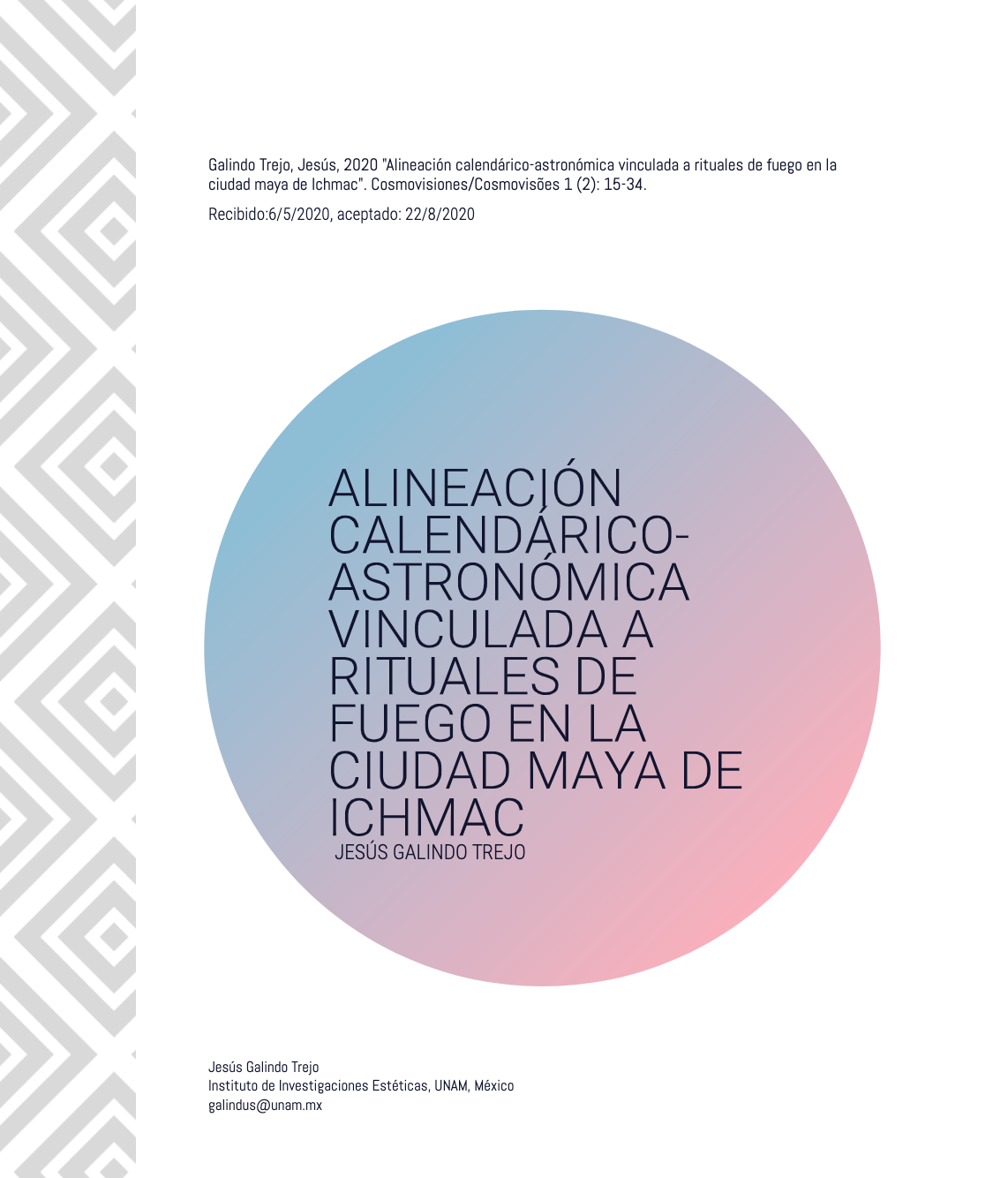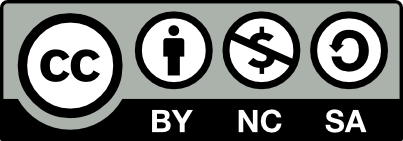Calendrical-astronomical alignment linked to fire rituals in the Mayan city of Ichmac
Keywords:
Mesoamerica, Maya people, Archaeoastronomy, CalendarAbstract
The city of Ichmac is located in the Yucatan Peninsula, its cultural apogee was between the 6th and 9th centuries AD. In one of the rooms of the so-called Building of Paintings, several polychrome pictorial scenes are conserved, although very deteriorated. In particular, an armed and richly dressed personage is holding an opponent warrior by the hair. This personage shows a solar hieroglyph in his headdress. The astronomical orientation of the building has been analyzed. Solar alignment occurs on localized dates at 65 days, before and after the winter solstice. Ethnohistorical sources describe four important ceremonies, every 65 days to complete a 260-day Tzolkin, dedicated to fire and performed by the Burners, priests who linked the directions of the Universe with the god Chaak and its associated colors. This practice reflects, on the one hand, the interest of the Maya priest-astronomers to assign to the architectural structure a symbolism of great ritual importance. On the other hand, the eagerness of the sovereign, who ordered the pictorial program, to express a message of political power.
Downloads
References
Alcina Franch, José 1993 Calendario y Religión entre los Zapotecos, Instituto de investigaciones Históricas, UNAM, México.
Andrews, F. George 1984 Ichmac. Architectural Survey Puuc Archaeological Region. Field Season, Vol. 3, University of Texas Libraries, Austin: 62-69.
Andrews, F. George 1986 Los estilos arquitectónicos del Puuc. Una nueva apreciación, Colección Científica 150, INAH, México.
Aveni, Anthony F. 1975 Possible Astronomical Orientation in Ancient America, Archaeoastronomy in Pre-Columbian America, edited by A.F. Aveni, University of Texas Press, Austin: 163-190.
Aveni, Anthony F. 1980 Skywatchers of ancient Mexico, University of Texas Press, Austin.
Aveni, Anthony F. y Hartung, Horst 1988 Archaeoastronomy and Dinastic History at Tikal, edited by A.F. Aveni, New Directions in American Archaeoastronomy, 46th International Congress of Americanists, Amsterdam, BAR International Series 454, Oxford: 1-16.
Benavides Castillo, Antonio 2000 Ichmac, un sitio Puuc de Campeche, Mexicon, Vol. XXII: 134-138.
Córdoba, Fray Juan de 1986 Arte del Idioma Zapoteca, 1571. Imprenta del Gobierno del Estado de Michoacán, Morelia.
Edmonson, Munro S. 1982 The Ancient Future of the Itza, The Book of Chilam Balam of Tizimin, University of Texas Press, Austin.
Galindo Trejo, Jesús 1994 Arqueastronomía en la América Antigua. CONACYT-Equipo Sirius, México, D.F.-Madrid.
Galindo Trejo, Jesús 2013 La traza urbana de ciudades coloniales en México: ¿una herencia derivada del calendario mesoamericano?, Zeitschrift Indiana 30, Berlín: 31-49.
Galindo Trejo, Jesús 2016 La orientación calendárico-astronómica de estructuras arquitectónicas en Mesoamérica, una práctica cultural de origen ancestral. El papel de la arqueoastronomía en el Mundo Maya: el caso de la isla de Cozumel, coordinado por Nuria Sanz, UNESCO, Paris: 21-37.
Galindo Trejo, Jesús y Casares Contreras, Orlando 2006 Alineación Prehispánica de Ciudades Coloniales: el posible caso de Mérida, Los Investigadores de la Cultura Maya No. 14, Tomo II, Campeche: 559-572.
Granados Saucedo, Francisco 2008 Observaciones astronómicas en el Centro Norte de México. Los casos de El Cerrito, Querétaro y Cañada de la Virgen, Guanajuato. Tiempo y Región. Estudios Históricos y Sociales, Vol. II, coordinado por Carlos Viramontes Anzures, INAH/ Universidad Autónoma de Querétaro/Municipio de Querétaro, Querétaro: 137-176.
Grube, Nikolai 2012 Der Dresdner Maya-Kalender. Der vollständige Codex, Verlag Herder, Freiburg.
Long, Richard C.E. 1923 The Burner Periods of the Maya, Man, Vol. 108:173-176.
Merk, Stephan y Krempel, Guido 2012 Monuments from Ichmac rediscovered at Rancho San Joaquín, Campeche, Mexicon, Vol. XXXIV: 144-148.
Pharo, Lars Kirkhusmo 2009 The Ritual Practice of the Yucatec Maya 260-Day Calendar in the Post-Classic Period: the Burner Ceremonies of Quadripartite 65-Day Intervals, Journal of Ritual Studies 23(1): 15-27.
Pollock, Harry E.D. 1980 Ichmac, The Puuc, an Architectural Survey of the Hill Country of Yucatan and Northern Campeche, Mexico. Memoirs of the Peabody Museum, Vol. 19, Peabody Museum of Archaeology and Ethnology, Harvard University, Cambridge: 474-480.
Ruiz Gallut, María Elena 2008 Entre formas, astros y colores: aspectos de la astronomía y la pintura mural en sitios del área maya. La Pintura Mural Prehispánica en México Vol. III, Oaxaca, tomo III, Estudios, coordinado por Beatriz de la Fuente, UNAM, Instituto de Investigaciones Estéticas, México: 283-293.
Sánchez Nava, Pedro Francisco y Sprajc, Ivan 2015 Orientaciones astronómicas en la arquitectura maya de las tierras bajas, INAH, México.
Sprajc, Iván 2001 Orientaciones astronómicas en la arquitectura prehispánica del centro de México, Colección Científica No. 427, INAH, México, D.F.
Staines Cicero, Leticia 1993 Murales Mayas en Ichmac, Chelemí y Xuelén, Campeche, Mexicon Vol. XV, No. 6:11-115.
Staines Cicero, Leticia 1995 Propuesta para el estudio iconográfico de la pintura maya del área norte, Revista de la Universidad Nacional, Nos. 528-529: 26-30.
Velásquez García, Erik 2017 Códice de Dresde, Edición Facsimilar, Interpretación, Arqueología Mexicana, Ediciones Especiales 67 y 72.

Downloads
Published
How to Cite
Issue
Section
License
Authors who publish in this journal agree to the following terms:
The authors retain intellectual authorship of the work and guarantee the journal the right to be the first publication of the work.
Authors may share the work with acknowledgment of authorship and the initial publication in this journal.
Authors may separately establish additional agreements for the non-exclusive distribution of the version of the work published in the journal (for example, placing it in an institutional repository or publishing it in a book), with an acknowledgment of its initial publication in this journal.
The journal offers free access ("open access") to all its content. The articles are available to be read, downloaded, copied, printed and/or researched according to the Creative Commons license: CC BY-NC-SA (Attribution - Non-Commercial - Share Alike-4.0 International)

The content of the journal is fully available from its publication. Readers are required to correctly cite the journal and the author of the downloaded content















